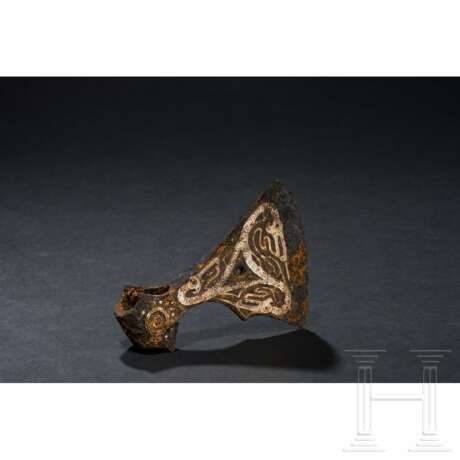Wikingeraxt aus Eisen mit Silbertauschierung im Jelling-Stil, Anfang bis mittleres Drittel 10. Jhdt.
03.11.2025 12:00UTC +01:00
Classic
Sold
7400EUR € 7 400
| Auctioneer | Hermann Historica |
|---|---|
| Event location | Germany, Grasbrunn / München |
| Buyer Premium | 25 % |
Archive
The auction is completed. No bids can be placed anymore.

ID 1478465
Lot 50 | Wikingeraxt aus Eisen mit Silbertauschierung im Jelling-Stil, Anfang bis mittleres Drittel 10. Jhdt.
Axt mit Schaftloch direkt im Nacken, beidseitig oben und unten mit spitz ausgezogenem Schaftlochlappen. Die Beilklinge mit leicht gewölbter Schneide auf der Oberseite einfach eingezogen. Die Unterseite zweifach eingezogen mit einer Spitze in der Mitte. Die Beilklinge in der Mitte durchlocht. Auf der Beilklinge auf beiden Seiten eine vollflächige Silbertauschierung: eine Triskele, deren drei Fortsätze, ausgehend von den Spitzen eines Dreiecks mit eingezogenen Seiten in je einem Drachenkopf mit langgestreckten Kiefern endet. Die Tauschierung auf jeder Seite mit Variationen in den Details: Auf einer Seite sind die zu einem Dreieck arrangierten bandförmigen Drachenleiber mit einem Zick-Zack-Muster mit Kreisaugen in den Zwickeln verziert, auf der anderen Seite mit Kreisaugen zwischen gekrümmten Linien. Auch die Köpfe sind unterschiedlich ausgeführt, auf einer Seite mit markant in mehrfach gebogenen, serpentinenartig ausgeführten, übermäßig gelängten Unterkiefern. Auf der anderen Seite mit gleichlangen Kiefern. Auch die Tauschierungen zu beiden Seiten des Schaftlochs im Nacken der Axt unterscheiden sich bei grundsätzlich ähnlich angelegter Komposition: Auf einer Seite ein Kreisauge mit konzentrische Linien, umgeben von Punkten, auf der anderen Seite ein geviertelter Kreis mit Punkten in den Quadranten, gleichfalls umgeben von Punkten. Auf dem Nacken der Axt eine kleine Triskele mit Spiralen an den Fortsätzen. Länge 14,7 cm. Höhe 11 cm. Oberfläche partiell rostnarbig und mit Eisenoxiden überzogen. Die Tauschierung aber gut erhalten und weitestgehend vollständig erkennbar. Ausgesprochen schönes und seltenes Prachtexemplar einer Wikingeraxt mit typische Merkmalen des Jellingstils.
Die Ergebnisse einer Röntgenfluoreszenzanalyse sprechen nicht gegen die Antike Herkunft des geschmiedeten Eisens.
KULTURGUT!
Provenienz: Süddeutsche Privatsammlung, übernommen in den späten 90er Jahren aus der Sammlung des Vaters.
Iron Viking axe with silver inlay in the Jelling style, early to mid-third of the 10th century
Iron Viking axe with silver inlay in the Jelling style, early to mid-third of the 10th century
Axe with shaft hole directly in the neck, with pointed shaft hole flaps on both sides at the top and bottom. The axe blade with a slightly curved cutting edge on the upper side is simply indented. The underside is indented twice with a point in the middle. The axe blade is perforated in the middle. On both sides of the axe blade there is a full-surface silver inlay: a triskelion, whose three extensions, starting from the points of a triangle with indented sides, each end in a dragon's head with elongated jaws. The inlay on each side has variations in the details: on one side, the ribbon-shaped dragon bodies arranged in a triangle are decorated with a zigzag pattern with circular eyes in the spandrels, on the other side with circular eyes between curved lines. The heads are also different, on one side with strikingly curved, serpentine, excessively elongated lower jaws. On the other side, they have jaws of equal length. The inlays on both sides of the shaft hole in the neck of the axe also differ, although the composition is basically similar: on one side, a circular eye with concentric lines surrounded by dots; on the other side, a quartered circle with dots in the quadrants, also surrounded by dots. On the neck of the axe is a small triskelion with spirals on the extensions. Length 14.7 cm. Height 11 cm. Surface partially rust-marked and covered with iron oxides. However, the inlay is well preserved and largely recognisable. An exceptionally beautiful and rare specimen of a Viking axe with typical features of the Jelling style.
The results of an X-ray fluorescence analysis do not contradict the ancient origin of the forged iron.
Provenance: South German private collection, inherited from the consignor's father in the late 1990s.
Condition: II -
| Auction house category: | Middle Ages and modern times |
|---|
| Auction house category: | Middle Ages and modern times |
|---|
| Address of auction |
Hermann Historica Bretonischer Ring 3 85630 Grasbrunn / München Germany | ||||||||||||||
|---|---|---|---|---|---|---|---|---|---|---|---|---|---|---|---|
| Preview | |||||||||||||||
| Phone | +49 (0)89 5472 649 0 | ||||||||||||||
| Fax | +49 (0)89 5472 64999 | ||||||||||||||
| Buyer Premium | 25 % | ||||||||||||||
| Conditions of purchase | Conditions of purchase | ||||||||||||||
| Business hours | Business hours
|


